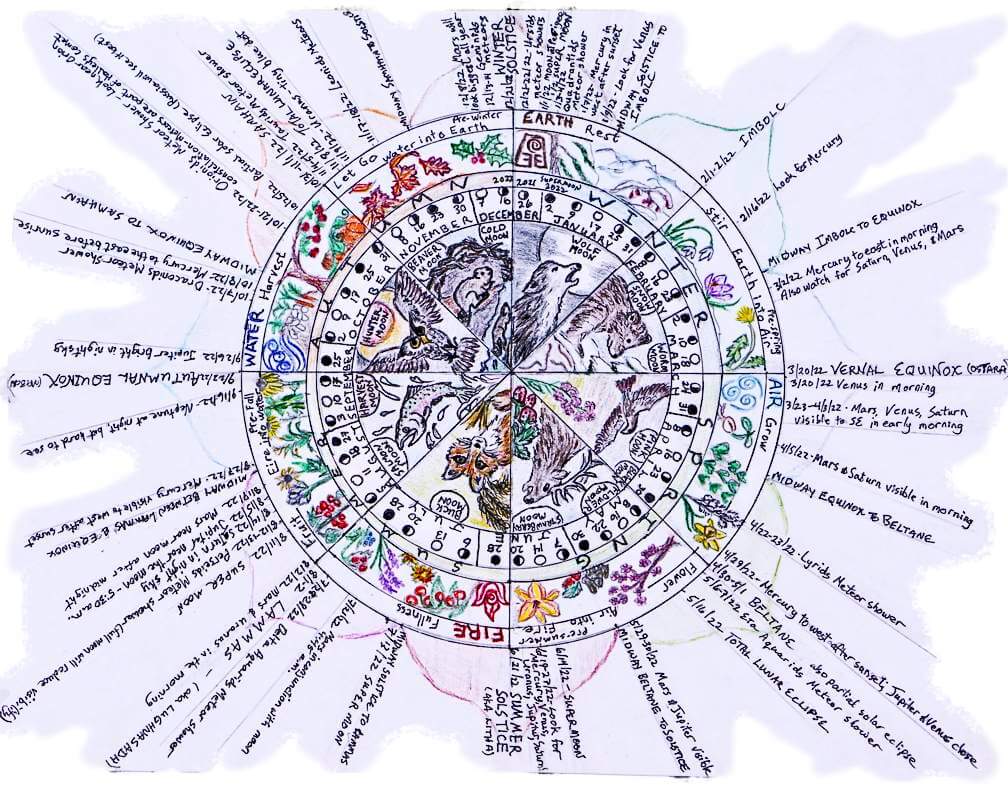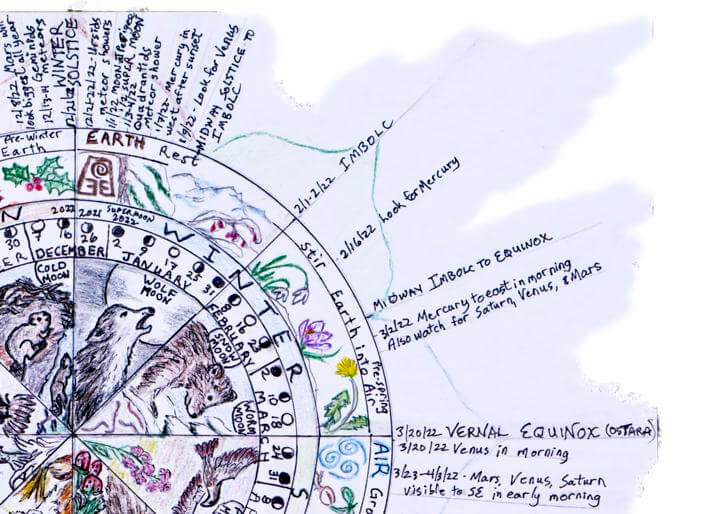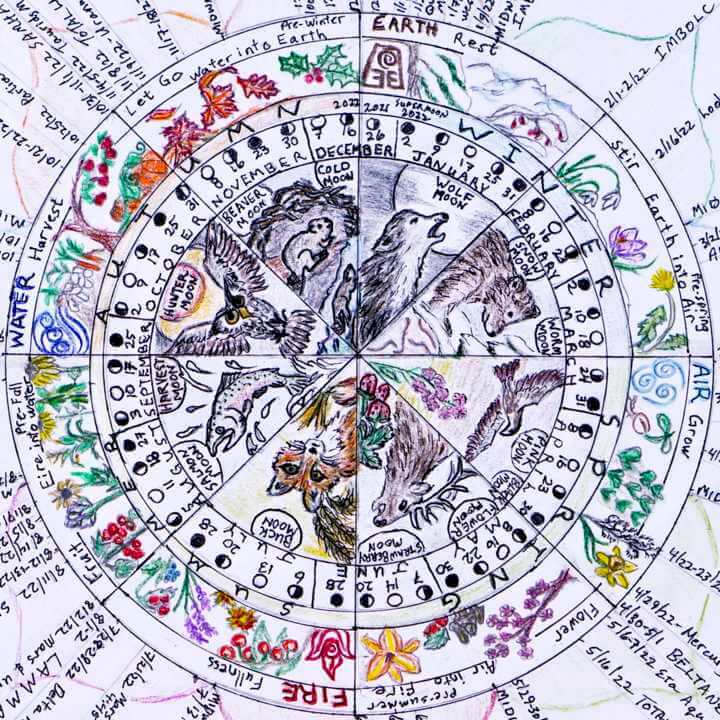Those of you who have signed up for the Barbolian Fields Fan Club know that I have long been promising a secret decoder ring of some sort. Well, my friends…
Behold the Barbolian Fields Earth and Sky Phenology Wheel Calendar!
(click link above to order! Thanks!)

It is not exactly a secret – but it IS a secret decoder – meaning it is designed to help us unlock the secrets of the world around us and beyond, based on how the world spirals through space and time. By the time we have completed a full Revolution around the sun (as noted in the title; no political coup necessary), we will be one year older than we were before.
How Does it Work?
We begin at the top on the Winter Solstice, which, for those of us in the Northern Hemisphere, marks the longest night and also the turning toward the light. To me, it is a logical point to begin anew – and also to begin a new year.
Someone might interrupt with the observation, “That’s fine for you folks up north, but not so for us on the equator or in the southern hemisphere.” True. We in the US tend to be US-centric like that, and it is a valid criticism.
First Challenge: How to Represent Time
So – the year is drawn in a circle (actually a spiral, but I am working in the 2-dimensional space of a sheet of paper; I used a flat circle for convenience.) As our mostly round but rather bumpy planet wobbles around the sun, it does so not in a circle, but in an ellipse. These rotations define our sense of day, night, seasons, and years.
We think of time as moving forward. We tend to be linear thinkers, and so we depict it as such as we watch ourselves aging in mirrors and photos. Plus, we like to be able to measure things, and that requires a reference point, hence our concept of a “timeline,” not a time circle.
But truly, what shape is time? Perhaps it simply expands and contracts – or maybe, like our waistlines, it just keeps expanding. Or maybe it does nothing at all; it is we who are doing the doing. Perhaps time is something beyond a tiny ball spinning around a star.
Ah. You see my problem. How do we decode the concept of time? And then it struck me: If we look at the natural world around us, we realize it needs no explanations.
And THAT, my friends, is why I devised the Earth and Sky Phenology Wheel Calendar.
How Do You Use It?
Simple. As noted above, begin at the Solstice. On each subsequent quarter of the year (Spring Equinox, Summer Solstice, and Autumnal Equinox), give the calendar a quarter turn until you are back at the beginning of what will be the next spiral into 2023.
But Wait…. There’s More
The Quadrants and Cross-Quarters

The 2022 circle is divided into the four quadrants of solstices and equinoxes. It also identifies the eighths, i.e., the cross-quarter days in the Celtic tradition, which are the points half-way between solstices and equinoxes. These are celebrated as Imbolc (February 1), Beltane (May 1), Lammas (aka Lughnasadh – August 1), and Samhain (October 31-November1).
And what about the mid-way points between the cross-quarter and the quarter days (the 1/16ths)? For example, that point halfway between Imbolc and the Vernal Equinox? I feel these are important points, too, which I will get to in a minute, and on the calendar, they are at the junctions of the flower petals lightly sketched in the background. Note that the points of the petals land on the quarter and cross-quarter points.
The Seasons
Of course, each season technically begins on the quarterly points, but truly, we can all see the changes that come before the solstice/equinox markers. This is where the 1/16th identifiers come in.
For example, although the Celts might celebrate February 1 (Imbolc) as the beginning of spring, here in the Pacific Northwest, the weather can still be quite miserable with freezing rain and even snow. However, give it 3 weeks (which would put the calendar at the 1/16th mark on ~2/22), and we begin to see enough additional hours of daylight that life begins to stir. Aha! NOW we are seeing signs of spring! Now we can start planting peas and greens. If we are lucky, we might hear a few peepers.
The outer circle follows seasonal changes in the plant kingdom:
- the snowdrops, crocuses, and dandelions of early spring;
- new sprouts and greens, daffodils and pussy willows in April;
- cherry and blackberry blossoms, strawberries, and an abundance of flowers in the flush of May and June;
- fruits coming on in July: cherries, raspberries, and more; the scent of lavender attracts the honey bees;
- tomatoes, artichokes, sunflowers, corn, and beans in the fullness of summer, when everything gets ripe at once;
- apples and squashes as we enter fall; we gather our root crops and get prepared for colder weather ahead;
- autumn leaves fall as the world goes to sleep;
- barberry and holly berries shine red beneath winter snows with the promise of a new spring….
The Elements
I have included the elements of Earth, Air, Fire, and Water on the calendar because these were used in many ancient cultures (Grecian, Tibetan, Indian, Islamic, and others) to explain nature and natural phenomena. The symbolism makes sense, does it not, that in winter, one turns inward toward the earth and hearth – a place of stability and “groundedness”; the winds blow strong in the spring, a time of new growth, new beginnings, fresh air; the sun burns like fire in the heat of summer when the crops are at their peak vitality; and the cooling rains are welcomed in the fall, when the rivers run high and wash away the grit, the leaves turn crimson and gold, and we are reminded of the importance of letting go.
The Moons
Meanwhile, the moon spins around the earth as the earth spins around the sun. We mark the quarter visibility of the moon’s waning and waxing, the dark or “new” moons, and the times when the moon is full. The tides ebb and flow accordingly.
Many cultures have given names to each of the passing full moons, but Native American tribes, in particular, gave them distinctive names that reflected their respective customs, hunting and foraging seasons, and the timing of changes in the natural world.
Northwest animals that correspond to these moons and seasons are depicted in the center circle: wolf, bear, hawk elk, fox, salmon, owl, and beaver.

The Galaxy
Finally, radiating out from the earthly sphere are the events beyond our atmosphere that if we step outside at night or early morning, we might be privileged to witness. We can now predict the timing of meteor showers, solar and lunar eclipses, and when and where various planets might be visible to the naked eye. Early astronomers before the invention of the telescope could not have imagined we would one day be pointing a phone device toward the sky that would accurately identify constellations!
I remember one summer night we were able to see Mercury, Venus, Mars, Jupiter, and Saturn – and at our feet, Earth – which is pretty incredible when you think about it – and that we even exist on here to witness it in the first place!
As the World Turns
As the Earth spins through the seasons, we nurture the stirrings in the plant world as it emerges from late winter / early spring and launches into rapid growth, then flowering, fruiting, and the push to produce seed before it’s too late.
Meanwhile, all creatures large and small are tuned into these patterns that determine food availability, whether that food be plant or animal. Light, wind, rain, temperature, soil, habitat, and timing are all variables that can affect success or failure on this life-and-death mission to grow and reproduce. Everything is happening all at once. And then suddenly, the year is over. Some will die, others rest, and still others have only been prepping for surviving the upcoming winter. And then we begin again.
It may seem so obvious that we take it for granted. After all, these are simple seasonal patterns, and animals will go where they find food, water, and shelter. True.
But what happens if something changes? What if one small thing can throw off all that perfect timing? How resilient is nature? And how resilient are we?
This is where Phenology comes in.
What is Phenology? And What Can We Learn from it?
The study of these cycles and how they interact is the study of phenology. Phenology describes the timing of biological events and how natural patterns and relationships might be affected by an assortment of factors, such as temperature, light, and habitat.
Native Americans were experts at recognizing these patterns, as evidenced by the full (and sometimes new) moons being named after what was happening during the year: snow moon, worm moon (stirring of the worms in the soil), flower moon, strawberry moon, buck moon, salmon moon, harvest moon, wolf moon… these all evoke strong images.
A Starting Point for Observing Change
The Earth and Sky Phenology Wheel Calendar is just a starting point. When we start to closely follow the changes of the season, moon phases, and the cycles of plants and animals, we also start to recognize patterns and interactions that appear to be working – or not.
We start to spot potential vulnerabilities to change, for example, whether there is enough cold water in the river in late summer for the salmon to swim upstream and lay eggs; whether insects will hatch at a time that coincides with when birds need them to feed their young; whether there are enough surviving small birds and rodents to feed the young hawks; whether there are enough nectar plants in enough places across the country for adult monarch butterflies to be able to migrate 3000 miles all the way to Mexico, where the oyamel fir tree canopy will keep the temperature not too hot and not too cold so they can safely overwinter before traveling north to mate and lay eggs on milkweed plants that will feed newly hatched larvae, which will repeat this process all over again.
How would we know about these amazing creatures if we did not pay attention?
Of course, predator/prey relationships are often in states of flux but manage to balance themselves out. But what if they don’t?
Something as small as a plankton in the ocean can precipitate a series of changes that can take many decades to resolve, if ever. As my best friend, Jeff Ward, is fond of saying, “Everything is connected to everything else.” He’s probably not the first to say that, but if you want to read an interesting article on how a reduction in kelp populations can cause a whole “trophic cascade” of changes, go to Why Kelp Matters.
We live in changing times, and how the changing climate affects food chains, food webs, the possible invasion or extinction of different species, and many more interrelated events is still left to be seen.
Observe and Interact
The first principle in permaculture design outlined by David Holmgren in “Principles & Pathways Beyond Sustainability” (2002) is to Observe and Interact. It is through the observing that we become more immersed in the world around us.
Nature has much to teach us.
How to Use Our Observation Notes
The calendar is just the beginning. It is up to each of us to keep track of the details of what is happening in our own environment. We can use the observations to help us make decisions.
Did a warm early spring cause the fruit trees to put on new growth too soon, which was then bit by late frosts? Did we have reduced pollination because a storm settled in right when the apple trees were at peak blossoming? These events can happen any year, but do they happen more frequently? Was it a particularly bad year for aphids or tent caterpillars? Where were the ladybugs or the parasitic wasps? Do we need to plant something to attract them?
How many “degree days” and “heat units” did we get? Perhaps we should grow different varieties of corn and tomatoes. Will flooding become more the “norm?” How can we minimize damage or store the excess for when we need it?
Eliot Coleman (The Winter Harvest Handbook [affiliate link]) coined the phrase, “Persephone Days,” based on the story of when the Greek goddess Persephone goes to live in the underworld for 4 months every year, during which time the ground above is barren. During the Persephone period, we have less than 10 hours of daylight and temperatures drop low enough that continued plant growth is slow to nonexistent. It is also why cold-tolerant kale grows much more slowly when planted in the fall as opposed to in the spring.
Do we know when the daylight at our latitude drops below 10 hours and when it increases again? Have we taken note of how plants and animals respond?
For the past couple of years, I have been using The Biotime Log, put together by Maddy Harland, illustrated by Jane Bottomley, published by Chelsea Green, an employee-owned publishing company (affiliate link), to record some of the happenings in our own backyard. It is handy because each page has places for 2 days and space enough for several short yearly entries. I do not write something every day, but I do hope to keep up with it. It only gets better and better over time. A simple notebook would also do. Or perhaps a monthly phenology wheel that inspires creativity. Truly, these can be anything you want them to be.
A Mix of Old and New
It occurs to me that our lives are highly enriched by both scientific discoveries and cultural traditions of many different peoples. We are also strongly influenced by our own ancestry, their stories, and by our environment. This Earth and Sky Phenology Calendar Wheel is a blend of all those things.
For me, it is a way of making sense in a very detailed way just how the world turns, oscillating on its axis from one season to the next, pulsating with the ebb and flow of life and death, spiraling into the next millennium.
Most of all, I think it is a way of making us more connected — something I think many of us have lost in modern society.
The more I observe and learn, the more I am awed by the immensity and complexity of our universe, from the tiniest aphid to the Milky Way. And as I stare out into the still of the night on this solstice eve – this longest night of the year – the Cold Moon shines clear and bright, high in the sky and surrounded by a glow – and it seems to radiate the promise that despite our current frigid temperatures, our planet will now begin its turning toward the light. I know this to be true, and I am just grateful to be here to witness it.
P.S. If you would like to purchase:
I originally made this wheel as a tool for myself and as a gift for my son and a good friend. I made a few extra copies. If you would like one, please Contact Me. More information can be found on this page: Earth and Sky Phenology Calendar Wheel.